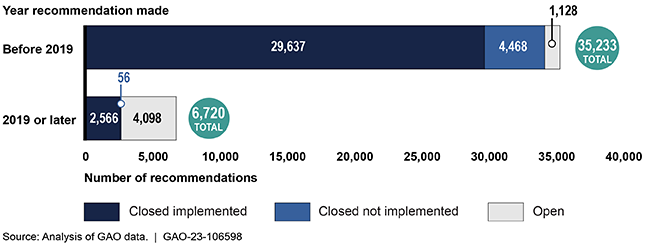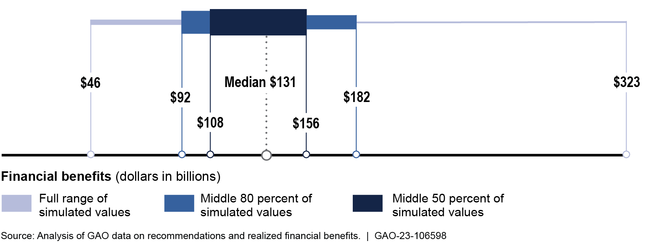Potential Financial Benefits: Estimating the Value of Implementing Open GAO Recommendations
Fast Facts
Our recommendations to federal agencies and our matters for congressional consideration produce measurable financial benefits for the government.
When Congress or agencies implement our matters and recommendations, government expenditures are often reduced, funds put to better use, or federal revenues increased. Over the past 3 years, our work has resulted in annual financial benefits ranging from $55 billion to more than $76 billion.
Yet, thousands of our recommendations and matters—5,226 as of May 8, 2023—were still "open" or not implemented. We estimate that implementing them could produce $92 billion to $182 billion in financial benefits.
Number of GAO Recommendations and Matters, Oct. 1, 2001 - May 8, 2023

Highlights
What GAO Found
GAO's recommendations for executive action and matters for congressional consideration consistently produce measurable financial benefits for the federal government. When agencies or Congress act on GAO recommendations and matters, government expenditures are often reduced, funds put to better use, or federal revenues increased. This work also results in better services to the public and improved government operations, but these other benefits cannot easily be measured in dollar terms.
Between October 1, 2001, and May 8, 2023, GAO recorded 875 instances of financial benefits totaling $739.2 billion. This is a conservative estimate; GAO limits the period of claiming financial benefits to 5 years, whereas some benefits accrue beyond this period.
As of May 8, 2023, 5,226 GAO recommendations and matters were open. Implementing all of those recommendations and matters could produce $92 billion to $182 billion of measurable, future financial benefits, according to a simulation model GAO developed. Eighty percent of the total simulated financial benefits fell in this range. The model produced a median simulated value of approximately $131 billion (see figure).
Simulated Financial Benefits of Implementing All Open GAO Recommendations and Matters

GAO estimates a range of potential financial benefits rather than a single estimate because of uncertainty about the probability and amount of financial benefits that may result from implementation. Several important factors may cause the simulation results to understate the total value of financial benefits. For example, a lack of data and other issues often make it difficult or impossible to measure financial benefits. In addition, historical data only identify up to 5 years of financial benefits from an individual recommendation, although these benefits could continue for longer periods. Finally, the simulation does not reflect certain individual recommendations that may have large potential financial benefits, such as one for equalizing certain Medicare payment rates that the Congressional Budget Office estimated could result in $141 billion in financial benefits.
Why GAO Did This Study
Over the past 3 years, GAO's work has resulted in annual financial benefits ranging from $55 billion to over $76 billion, and more than 1,200 other benefits each year. GAO has previously reported that, based on available estimates for individual recommendations and matters, tens of billions of dollars in additional financial benefits could be achieved if GAO's open recommendations and matters were fully implemented.
The Joint Explanatory Statement accompanying the Consolidated Appropriations Act, 2023, includes a provision for GAO to provide additional detail on the potential financial benefits associated with open GAO recommendations. This report provides estimated ranges of potential financial benefits, both in total and for selected entities, which could result from implementation of all open GAO recommendations and matters.
To estimate ranges of potential financial benefits, GAO developed simulation models using GAO's historical data on recommendations and matters and realized financial benefits. To ensure a sufficient number of open recommendations and matters for each simulation, GAO selected the 10 entities—nine agencies and Congress—with the largest number of open recommendations and matters.
GAO identified and mitigated limitations related to using the historical data for the simulation model by testing several alternatives. Real-world financial benefits will depend on whether, how, and when recommendations and matters are addressed.
For more information, contact Jessica Lucas-Judy at (202) 512-6806 or lucasjudyj@gao.gov, or Michael Hoffman at (202) 512-6445 or hoffmanme@gao.gov.
